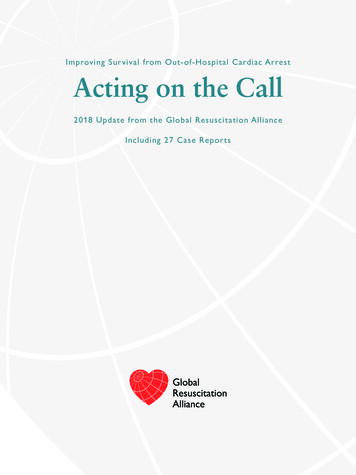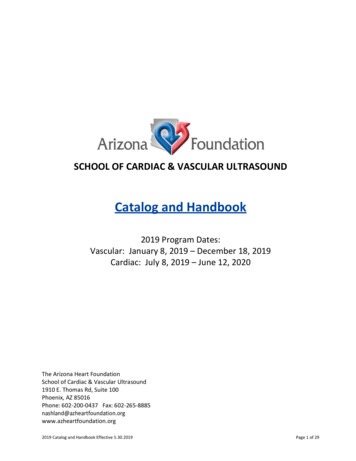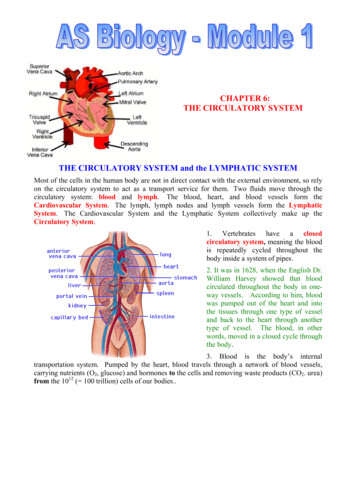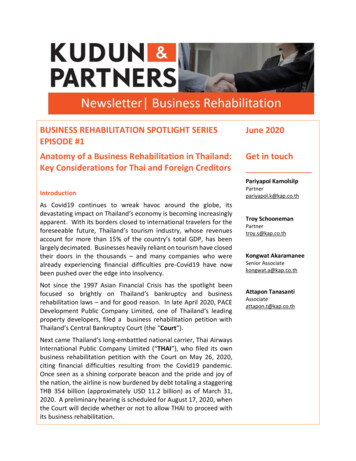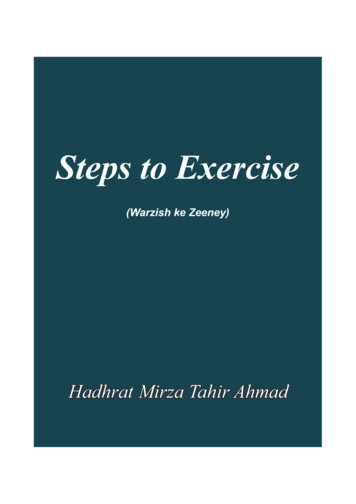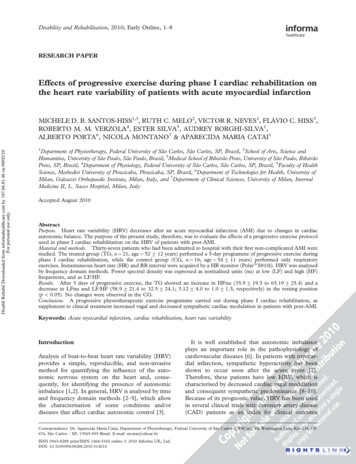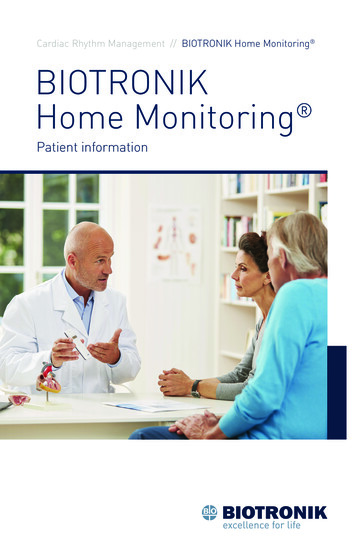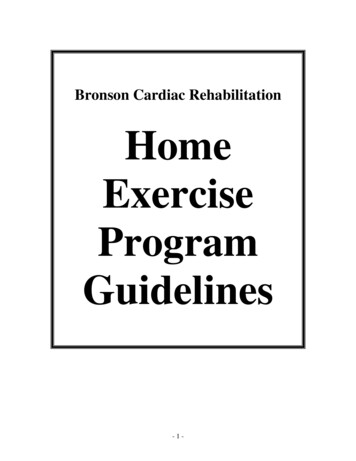
Transcription
Bronson Cardiac RehabilitationHomeExerciseProgramGuidelines-1-
Table of ContentsIntroduction 2Words to Know .3Exercise Is Medicine .4Exercising At Home . 5 Warming up and Stretching . . . 5 Aerobic Training. . 8 Resistance Training .13 Cool-Down . 17The MET. . 18Other Considerations 20Weight Management. . . 24Activity Log . . 28Notes . 30Contacts . 31IntroductionThis book has been designed to help you with your home exercise activities.Definitions of words often used are included as well as an explanation of theparts of an exercise program, and the importance of each part.This book will give you specific information to follow so that you mayfollow your exercise program safely. Some of these activities includewalking, swimming, bicycling, and jogging for some. The information isbased on your performance in our Cardiac Rehab program.-2-
Words to KnowHere are some key words about your exercise program that will be used in this book oryou may have heard during class.Aerobic Activity: A sustained repetitive activity performed for a long period.Resistance Training: This is exercise targeting specific muscles to improve strength.MET: Metabolic Equivalents, The oxygen your body consumes per unit of body mass.Target Heart Zone (THZ): This is the heart rate range for you to exercise in duringaerobic activity.Rating of Perceived Exertion (RPE): Your feeling of how hard you are working basedon a 6 through 20 scale where 6 is seated doing nothing, and 20 the hardest work you canimagine.Shortness of Breath (SOB): A way to rate how you are breathing where 0 is noshortness of breath, and 4 you are so short of breath you need to stop your exercise.Angina: Discomfort caused by lack of blood flow to the heart muscle. This may beexperienced as pressure, tightness, or heaviness in the chest arm neck jaw or back.Warm-Up: This is the activity before exercise such as an easy walk and stretching tohelp improve blood flow to the body and aid in avoiding injury.Cool-down: This is the activity after exercise such as an easy walk and stretching to helpbring the body back to a resting state.Ejection Fraction (EF): The amount of blood pumped by the heart muscle for eachheartbeat.HDL: High-density lipoprotein is considered “good” cholesterol and used to help carryaway cholesterolLDL: Low-density lipoprotein is considered “Bad” cholesterol and associated with anincreased risk of heart disease.Peripheral Artery Disease (PAD): Blockage of the blood vessels in the legs making itpainful to walk for long periods.-3-
Exercise is medicineAn inactive lifestyle and poor dietary habits are two of the biggest causes of healthproblems. Thinking of exercise as another medication that will be “taken” daily will havemany positive health benefits. Some of these benefits are: Lower blood pressure. Higher HDL “good” cholesterol and lower LDL “bad” cholesterol. Weight loss Better control of diabetes and blood sugar Reduced fatigue and more energy Better sleep patterns Decrease bone mineral loss Better joint function Increased exercise capacity and the ability to more easily complete daily tasks Improve PAD and Angina thresholds making it easier to complete tasks withoutpain. Return to work soonerYour active role in an exercise program, gradually increasing the amount of exercise youdo, can help to reduce the number of times you visit the hospital as a patient, make yourdaily activities more enjoyable, and allow you to live a longer more satisfying life.Think of exercise as medicine! Don’t stop doing your exercise because you are feeling“good”. Following your exercise prescription will help you continue to feel good andgive you control over your health.-4-
Warming UpWarming up prepares your body for the activity. The warm up should include a low levelactivity such as easy walking or pedaling your bike with out tension for 3-5 minutes.Stretches will help improve flexibility and avoid injury. This warms up the muscles byslowly increasing blood flow, increasing your heart rate and opening blood vessels.Breathe normally as you stretch. Do not hold your breath or bounce while you stretch.Stretch to the point that you feel a light pull on the muscle you are stretching. Hold thisfor 30 seconds. The following are the stretches you perform at Cardiac Rehab.StretchesCalf StretchStarting Position: Stand an arms length away from a wall or chair using your hands forsupport. Your toes should point straight ahead. Place your right foot forward and your leftfoot back.Exercise: Bend your right knee keeping the left knee straight and your left heel flat on thefloor. As your hips move forward, you should feel a stretch on the lower left leg. Holdthis position for 30 seconds, and then repeat with the other leg.-5-
Achilles StretchStarting Position: Stand in the same position as with the calf stretch.Exercise: This time bend both knees keeping both heels flat on the floor. Bend until youfeel a stretch behind the ankle of the leg that is back. Hold this position for 30 secondsand then repeat with the other leg.Lower Back and Hamstring StretchStarting position: Stand with your feet shoulder width apart or in a comfortable positionfor you. You may stand next to a table or chair to help you with your balance.Exercise: Bend at the hips keeping you knees strait but not locked until you feel a pull inthe back of the legs and in the lower back. Hold this position for 30 seconds. Bend yourknees slightly and slowly return to the standing position.-6-
Thigh StretchStarting Position: Stand by a chair or wall where you can hold on for balance.Exercise: Bring your right knee up with your right foot behind you. With your right handgrab either your right foot or ankle and gently pull it further behind you until you feel apull on the muscles on the front of your leg. Hold this position for 30 seconds, and thenrepeat with the left leg.Once you have stretched your muscles and warmed up properly, you may begin yourexercise session.-7-
Aerobic TrainingThe word aerobic means needing air or oxygen. Your body uses oxygen during exerciseto produce “fuel” so you may continue the activity. This “fuel” production includesburning calories in the form of fat stored on the body as well as carbohydrates. Duringexercise, you continue to produce fuel and use the fat stores to help you with your weightloss goals.Aerobic exercise is repetitive and sustained movement. It usually involves large musclegroups, such as the legs, for a long period. Examples of aerobic exercise ntry skiingPeople also refer to these activities as doing “Cardio” or cardiovascular exercise(involving the heart, arteries, and veins). These activities may involve the use of exerciseequipment like treadmills, elliptical machines, or stair steppers. We encourage you tryactivities that you will enjoy and will most likely continue with on your own.Target Heart RateYou wear a heart monitor during cardiac rehab. The monitor gives your clinicians feedback on how fast your heart is beating and whether it is in a “normal” rhythm for you.We developed a Target Heart Rate range (THR range) during this time to help youexercise within an appropriate and safe level. We want you to continue with yourexercise at home in the same manner, and have developed a THR range we feel is best foryou.* Your THR range for home exercise: to .You can track this THR range by counting your pulse for 15 seconds and multiplying by4. You can use the conversion table on the following page for quick reference. You maywant to memorize the numbers that relate to your heart rate range to more easily check tosee if you are in your target range.You can find your pulse on your wrist by turning your palm upward. Lightly press on thethumb side between the bone and the tendon with the first two fingers of the oppositehand. You should feel a pulsation against these fingers. Count the number of times youfeel this in 15 seconds.-8-
If you have trouble feeling your pulse, consider buying a pulse-meter. There are manybrands and a few different types. The most commonly used is a pulse-meter that has achest strap transmitter and wristwatch receiver. This type of pulse-meter reads your heartrate continuously. Other types of meters have a clip that attaches to your ear lobe orfinger and cord going to the meter, or a wristwatch that you press on with your fingers toget the heart rate.DurationWhen first starting an exercise program you need to moderate your duration for what youcan tolerate. If you are a person who has never exercised you may want to start with 5-10minute intervals 2-3 times a day (Interval Training), as long as you are not wearingyourself out. As you progress with your tolerance, you can add time. We suggest adding5 minutes to your routine every week or every other week, deciding by how you feel. Tryto do a duration that is about the same as what you are doing at Cardiac Rehab. Overtime, you should increase your activity to exercising all at one time and without breaks(Continuous Exercise), and for durations of 45 –60 minutes a day.Your Duration: . Try to increase by 5 minutes everyother week.FrequencyFrequency of exercise refers to the number of days each week you will exercise.Moderating your frequency (How often you exercise) when you start an exercise programis also important. We have started you off with a few sessions at Cardiac Rehab, and nowwant you to increase the number of times you exercise each week. Ideally, werecommend exercise on most days per week, or 5-6 days each week. You are scheduledto exercise at Cardiac Rehab Monday, Wednesday, and Friday, and we encourage you toexercise on the days you are not here (Tuesday, Thursday, Saturday or Sunday). You canleave yourself one to two days each week without exercise or for an easy walk if youwant.Your Frequency: 5-6 days weekly . You do not need to exercise on the days you arescheduled for Cardiac Rehab (Monday, Wednesday, and Friday).-9-
Conversion Table for 15 Second Pulse CountBeats per 15 Sec. Beats Per MinBeats per 15 Sec. Beats Per Min10 . .4026 10411 . .4427 10812 . .4828 11213 . .5229 11614 . .5630 12015 . .6031 .12416 . .6432 .12817 . . .6833 .13218 . .7234 .13619 . .7635 .14020 . .8036 .14421 . .8437 .14822 . .8838 .15223 . .9239 .15624 . .9640 .16025 . .10041 .161- 10 -
Rating of Perceived ExertionIf you are unable to feel your pulse or your heart rhythm does not allow you to count yourheart rate accurately, you can use the Rating of Perceived Exertion (RPE) to help trackyour work level. This scale starts at the number 6, which you can think of as being seatedin a chair doing no work at all, and progresses to the number 20, which would be thehardest work you could possibly think of. There is a range that we want you to maintainon this chart as well.Rating of Perceived Exertion67 . Very, very light89 . Very light1011 . Fairly light1213 . Somewhat hard1415 . Hard1617 . Very hard1819 . Very, very hard20Perceived exertion refers to the total amount of physical effort you are experiencing. Thisscale takes into account all sensations of exertion, physical stress and fatigue. When youuse the rating scale, try to concentrate on your total “inner” feeling of exertion. Thisincludes leg fatigue and discomfort with labored breathing and total effort you areexerting.Your RPE range for home exercise: 11 fairly light to 13 somewhat hard.- 11 -
Talk TestIt is also important to monitor your breathing. We use the “Shortness of Breath Scale” inour cardiac rehab program to more closely follow your progress. This scale starts at 0 orno shortness of breath and progresses to the number 4 or being so short of breath youneed to stop. For home exercise we want you to monitor your breathing during exerciseby using a Talk Test. With the talk test, you should be able to carry on a conversationwithout needing to stop to catch your breath during your activity.Setting your EquipmentNot all equipment is created equal, and not all equipment settings will be the same as theequipment you use at cardiac rehab. We will try to help you with setting your equipmentfor home. You will need to go more by how your equipment feels when comparing it toours. This is especially true with bicycles. We can give settings for treadmills andSchwinn Airdyne bikes, as these are typically very similar.Treadmill Settings: MPH % GradeSchwinn Airdyne settings: RPM LevelPain ScaleAre You In -------I-------I------I------I------I0123456789 10No PainMild PainModerate PainSevere PainVery severePainWorstPossiblePainBe sure to monitor your pain level. Stop exercise and report any unusual pain to yourcardiologist or primary doctor. The scale above is the scale used in cardiac rehab and willhelp you to better report your pain.- 12 -
Resistance TrainingThe goals of resistance training are to increase the amount of lean muscle on your body,and improve your ability to complete your daily activities such as shopping, housecleaning, yard work, and hobbies.By increasing muscle tone and mass, your body will burn more calories during the day(even at rest) since muscles burn calories and fat does not. This will also improve yourmuscle tone so that you both look and feel better.While you are in the cardiac rehab program, the weight routine is part of your exerciseroutine. You will not need to do them at home. Once you have completed the cardiacrehab program, you will want to continue with the weight routine on Monday,Wednesday, and Friday. Your muscles need a “rest” day for rebuilding and repairing themuscle tissue and to avoid over use of these muscles.Use a weight that will allow you to complete 12-15 repetitions without too muchstraining. Breathe normally throughout the routine. Do not let the weights drop, or usefast motions. These motions can cause damage to the tendons and ligaments that attachyour muscles to your bones. Use slow, smooth motion through each movement. Do nothold your breath. This can cause you to be lightheaded and possibly pass out. Start outby completing one set of each exercise, and add a set when you can tolerate more, up to 3sets of each exercise. You may also consider using Thera-bands as an alternative,starting with a tan color, least resistive, progressing through (yellow, red, green, blue,black) to silver, most resistive.Use the pictures and explanations of the exercises on the following pages to help guideyou through the weight activities.- 13 -
Biceps CurlStart with your arms at your sides and your palms facing forward. Bending at your elbow,bring your hands up to your shoulders keeping the upper arms still. Slowly return yourhands to the starting position and repeat.Repetitions: 12-15, Sets: 1 to 3 as you can tolerate.Shoulder PressStart with your hands next to your ears with your palms facing forward. Push your handsstraight up over your head and then slowly return them to the starting position next toyour ears and repeatRepetitions: 12-15, Sets: 1 to 3 as you can tolerate.- 14 -
Upright PullsStart with your arms at your side and palms facing your body. Pull your hands up yoursides to you chest level, and then slowly return them to the starting position at your sidesand repeat.Repetitions: 12-15, Sets: 1 to 3 as you can tolerate.TricepsStart with your arms straight up over your head. Slowly lower the weights behind yourhead keeping your elbows pointed up toward the ceiling, and then return them to thestarting position up over your head and repeat.Repetitions: 12-15, Sets: 1 to 3 as you can tolerate.- 15 -
Lateral FlyStart with the weight at your side. With a smooth motion bring your hands outward fromyour body and straight up to your shoulder level. Follow the same motion returning theweights to your sides and repeat.Repetitions: 12-15, Sets: 1 to 3 as you can tolerate.Front Deltoid RaiseStart with your hands at your sides. Raise your hands up in front of you to your shoulderlevel keeping your arms straight. Slowly return them to the starting position at your sidesand repeatRepetitions: 12-15, Sets: 1 to 3 as you can tolerate.- 16 -
Cool DownThis is the period immediately following your activity and will help your body return tothe pre-exercise state.The purpose of the cool down is to:- Gradually return your heart rate to pre-exercise levels- Prevent blood from pooling in your legs and to help avoid dizziness- Improve your flexibility by stretching the muscles you have been using- Help you avoid muscle soreness.The cool down period should begin by lowering the intensity of your exercise to a slowwalk or easy pedaling on a bicycle with little resistance. Following 2-5 minutes of thislower intensity, repeat the stretches discussed earlier. You performed these sameactivities before exercise. They will help to relax the muscle, improve and maintainflexibility, and help to prevent injuries and soreness. This cool down process should takebetween 5-10 minutes.- 17 -
The META “MET” is a measure of work level used to help calculate calories and fitness level. It isdefined as the amount of oxygen your body uses during exercise per kilogram of bodyweight per minute of exercise. Knowing your MET level can help you determine theactivities you will be able complete at home. For example, someone who is able to walkon level ground at 4 mph (about 4 METs) would be able to: stock shelves, do plumbing,do general housework, bowl, golf with a pull cart, or climb stairs. The following chartmay help you to determine the activities that would be safe for you based on the level ofexercise you are doing in cardiac rehab.Your Met Level :ExerciseRecreational1.5-2.0METsStrolling 1-1.5mph1 miles in 4060minDesk work; Drivingauto/truck; SittingKnitting; Playing cards; doing lightSewing; Watching TV assembly; Typing;Using hand tools;writingBrushing hair/teeth,Light housework,Making bed; Partialbath; Polishingfurniture; Washingclothes2.0-3.0METsWalking, level2.0-2.5 mph,1 mile in 2430minCycling, leveloutdoors-5mphHorseback riding(walk); Light golf(power cart); Playingmusical instrument;Shuffleboard;WoodworkingBartending; Craneoperation; Standingdoing light ormedium assembly;TV/auto/car repair;Working heavy leverCooking; Driving car;Ironing; riding lawnmower; Scrubbingfloor; walls, cars,windows; Showering;Sweeping; Tub bathBilliards; Bowling;Canoeing; Croquet;Fly fishing; Golf(pulling cart);Shopping; Volleyball(non-competitive)Baling hay; Drivingheavy truck; heavymachine assembly;Janitorial work; Lightwelding; Operatinglarge levers;Plastering;Plumbing; StockingshelvesCleaning windows;Climbing stairs(slowly); GeneralHouse work;Kneeling; Light work;Packing/unpacking;Power lawn mowing(light); Sexualintercourse; Stockingshelves; VacuumingBallet; Dancing;Gardening (how,weeding, digging),Golf (carrying clubs);Table tennis; Tennis(doubles); VolleyballBuilding interior ofhouse; Carryingtrays/dishes; Farmwork (sporadic);House painting,Lifting, carryingobjects (20-40 lb);Light carpentry;Mechanic workRaking leaves,shoveling light loads3.0-4.0METsWalking 3.0-4.0mph,1 mile in 1520minCycling,outdoors5.5 mph4.0-5.0METsWalking 3.5-4.0mph1 mile in 15-17minCycling, 8 mphCalisthenicsSwimming (20yd/min)OccupationalActivities of DailyLivingMETs- 18 -
Activities of -6.0METsWalking4.0-4.5 mph1 mile in 13-15minBiking, 10 mphCanoeing (4m/hr);Gardening (digging);Skating (ice/roller);Social/square dancing;Softball/baseball (nongame); Stream fishingHandyman work(moving, shoveling); Raking leaves,Heavy Carpentry;shoveling light loadsPutting in sidewalk6.0-7.0METsWalking/jogging,4.0-5.0 mph1 mile in 12-13minBiking, 11 mphSwimming(breaststroke)Backpacking (light);Badminton; Hiking;Hunting; Horsebackriding (trot), Skiing(cross country 2.5mph); Skiing (lightdownhill); Squaredancing; Tennis(singles)Exterior homebuilding; Lifting,Lawn mowing (pushcarrying objects (45mower); Snow64 lb); Shovelingshoveling (light snow)(10/min, 9 lb);Splitting wood7.0-8.0METsWalking, 5 mph1 mile in 12 minBiking(outdoors) 12mphSwimming(backstroke), 40yd/minBadminton(competitive);Basketball (nongame); Canoeing (5mph); golf (carryingbag); Horseback(gallop); Skiing(downhill, vigorous)Ascending stairswith 17 lb load;Lifting, carrying (6584 lb); Moving heavyfurniture; SawingJog/run 5.5 mphBiking(outdoors) 13mphSwimming(breaststroke)40 yd/minRowingmachine; Ropejumping (60-80skips/min)Basketball (nongame);Handball/squash/racquetball; Mountainclimbing; Soccer (nonteam); Touch football;Tour skiingLifting, carrying (85100 lb); Movingheavy furniture(moving van work);Shoveling (14 lbscoops, 10scoops/min); Usingheavy tools8.0-9.0METs8.0-9.0METs9.0-10.0METsHeavy labor;Jog/run, 6 mph Football (competitive); Lumberjack;1 mile in 10 min sledding/tobogganing Shoveling (16 lbscoops)- 19 -Ascending stairscarrying 54 lb
Other ConsiderationsClothingChoose clothing that is suitable for the activity, location, and weather such as shorts and at-shirt in warm conditions and layered clothing in cool to cold conditions. You mayconsider clothing that wicks sweat away from your body as you exercise. This will helpto keep your body cooler in warm conditions and warmer in cooler conditions. Layeringyour clothing allows you to “peel off” the layers in cooler weather as your body heats upduring your activity.Drinking waterSweating is the bodies’ way of naturally keeping your core temperature at about 98.6degrees. Sweat evaporates from your skin causing a cooling effect so that you don’t overheat. As you continue to exercise, you need to replace the water that is evaporating sothat your body can continue to keep you cool and function properly. If you cannot sweat,your body will over-heat. This can lead to heat exhaustion, heat stroke and even death. Agood rule of thumb is to drink 8 oz of water for every 15 minutes of activity that you do.There are many options for carrying the water with you from water bottles to back packtype containers.ShoesA quality well fitting walking or jogging shoe is important if you are participating inthese types of activities. Buy your shoes for how they fit rather than the style, color,brand name, or price. Your shoes should provide support, cushioning, and should fitsnuggly but be comfortable. The following checklist can help you to make an educatedchoice:1. Try on shoes at the end of the day. Your feet are the biggest at this time and willallow you to more accurately size your shoes.2. Wear the same thickness of socks that you will be wearing during your exercise.3. The flex joint of the shoe (where the sole bends) should bend where your footbends. If the shoe bends back near your arch, your feet will be sore from stifffitting shoes.4. The heel should fit snuggly. The ankle should be above the top of the shoe collar.5. The heal counter should be rigid to help stabilize your heel. A notched heel tabtakes pressure off your Achilles tendon during the heel and toe motion.6. Walk in the shoes, not just in the store, but take them out for a good “test walk”off the carpeting.7. Buy your shoes from a store with a reliable reputation and with trained personnelfitting you. What are their credentials?- 20 -
8. Take the time to try on different models and different brands to help find the shoethat make your feet happy. Don’t be afraid to ask questions.Heel TabCollarToe BoxHeel CounterMid SoleFlex jointLow HeelCold Weather ExerciseTake precautions when exercising outside in cold weather. Layer your clothing to wickaway sweat, insulate against the cold, and provide a shell to guard against the wind. Thiswill help to maintain your body’s core temperature. Keeping the skin covered in the coldweather will help you to avoid frostbite and damage to tissues. A hat and gloves arerecommended. Forty percent of your body’s heat loss occurs through the head, arms andlegs. Use a scarf or mask that will cover your face and nose in weather below 30 degrees- 21 -
to help warm the air you breathe in. The cold air can cause your blood vessels toconstrict. This can cause angina (heart pain), and can cause an asthmatic reaction forpeople with asthma. Snow and ice could mean injuries from falling. We recommendexercising indoors when outside temperatures are less than 30 degrees (including thewind chill factor).Hot Weather ExerciseDuring exercise on warm or humid days, more blood is directed toward the skin to aid thebody in staying cool. Less blood is available for your working muscles and your heartrate will increase in response to this. You will find that you will need to lower yourintensity of work to maintain your THR; otherwise, your heart rate may get too high andmake you more susceptible to dangerous heart rhythms.During hot weather, we recommend exercise in the cooler parts of the day (early in themorning or late in the evening), or exercise indoors in an air-conditioned or coolerenvironment. Drink plenty of water before and after your workout. Try to drink 8-16ounces of water for every 15 minutes of exercise while you are active. Do not exercise intemperatures above 92 degrees (including the heat index and humidity). Stop exercisingif you are feeling light headed, have extreme thirst or feel as if you are overheating.Be aware of ozone and carbon monoxide levels. These may cause constriction of thebronchial tubes and decrease the amount of oxygen transported to the muscles by theblood. During “ozone action” days or when the air quality is poor, avoid outdoor activityespecially if you have asthma or emphysema.IllnessIf you are ill, rest and allow your body time to recover. Avoid exercise if your illnessincludes any of the following: fever, body aches, nausea and vomiting, and chestcongestion. If you miss three or more consecutive days of exercise, restart your programat a lower level of intensity, and at a shorter duration. As you feel better, you can resumeyour usual level of activity.Time of DayTime of day for exercise is very dependent on the person. Morning is typically whenpeople are the most motivated to complete an exercise program. This helps to avoidscheduling issues that may put off exercise for another time. Try to avoid exerciseimmediately after a meal (for at least 1 hour) due to the body’s high demand for bloodduring digestion. This will elevate your heart rate and reduce the level of exercise youmay do. Noontime may work well for some, and can add a much-needed break to the dayas well as help to avoid heavy lunches. Early evening exercise may help a person to- 22 -
unwind and relax after a hard day. Try to avoid exercising immediately before bedtime.This may make getting to sleep difficult. Other things to consider are medicines you takeand how they affect you (heart rates, blood sugar levels, bathroom breaks) and how youmay need to change you activity.Avoid InjuryPerforming too much exercise too soon is the most common cause of exercise relatedaches and pains. The injury risk can be reduced by beginning the program at a lower leveland gradually increase your time and how hard you work. Add 5 minutes to your exercisetime per week or every other week, and try to remain in your THZ or RPE level. Nonweight bearing activity (cycling, swimming, rowing) as opposed to weight-bearingactivity (running or jumping-type activities) can help reduce the risk of injury.The “Best” Form of ExerciseThe “best” form of aerobic exercise is the one that keeps you motivated and the one youwill continue to complete every day. Though this may be true, a variety of activities willhelp to keep the exercise fresh and interesting. As long as the exercise is matched interms of THZ, and RPE level, the benefits will be very similar.Hot Tub UseDo not use a hot tub until the doctor gives the OK. This is generally 3 months aftersurgery. The temperature of the water is best kept under 104 and exposure time shouldbe limited to 5 minutes or less. If you begin to feel lightheaded or dizzy, it’s a sign youshould carefully get out of the pool, cool off and drink some water. Always beaccompanied by another person. Do not lift yourself with your arms if your surgery waswithin the last 3-6 months.- 23 -
Calories and Weight ManagementThe number of calories expended during exercise depends on the intensity and durationof exercise as well as the size of person. Larger people expend more calories than smallerpeople do during weight bearing activities. The average person can expect to expend 100calories walking 1 mile. One pound of fat is equal to 3500 calories. To put this intoperspective, to lose 1 pound of fat through exercise, you would have to walk 35 miles.Weight loss is more easily achieved by reducing your calorie (food) intake and increasingyour activity level. Your goal should be 1-2 pounds of weight loss each week.What is the plan for “Weight Management”?Every good weight-loss program has the same two parts: healthful food choices andphysical activity. Wise food choices can help you eat fewer calories and physical activityincreases your fitness level. Attention to healthful food and activity will help you loseweight more easily, and you’re more likely to keep it off too.Choosing a Weight Managemen
- 3 - Words to Know Here are some key words about your exercise program that will be used in this book or you may have heard during class. Aerobic Activity: A sustained repetitive activity performed for a long period. Resistance Training: This is exercise targeting specific muscles to improve strength. MET: Metabolic



